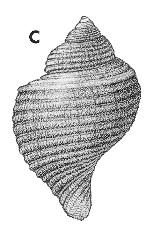
Revised descriptions of New Zealand Cenozoic Mollusca from Beu and Maxwell (1990)

 | Revised descriptions of New Zealand Cenozoic Mollusca from Beu and Maxwell (1990) | 
|
  (Pl. 48c): Te Piki, Cape Runaway, near East Cape, Haweran (oxygen isotope stage 7; M49096, National Museum of N.Z.) |
Beu & Maxwell (1990): Chapter 16; p. 355; pl. 48 c.
Synonymy: Buccinum caudatum Gmelin 1791, p. 3471; Fusus cutaceus Lamarck 1816, "Liste des objets" p. 6; Cassidaria cingulata Lamarck 1822, p. 216; Fusus voigtii Anton 1838, p. 77; Triton undosum Kiener 1842, p. 44; Ranularia (Lagena) rostratus Mörch 1852, p. 110; Triton (Linatella) poulsenii Morch 1877, p. 33; Linatella neptunia Garrard 1963, p. 43; see Beu & Cernohorsky 1986 for full synonymy
Type species of Linatella Gray, 1857
Classification: Ranellidae: Cymatiinae
Description: Moderate-sized to large for family (34-96 mm high), with moderately tall, weakly stepped spire (0.5-0.66 aperture and canal), strongly inflated whorls, and moderately long, widely open, straight to strongly recurved anterior canal with weak fasciole. Whorls weakly angled (at upper third of whorl height on spire) and with few small nodules around shoulder angle on some specimens; axial sculpture otherwise of faint growth ridges only. Sculpture of many prominent, wide, convex-topped spiral cords, of even width and height and with narrow, flat-bottomed interspaces in most specimens, but variable; some have regularly alternating narrow and wide cords, whereas others have wide cords with only linear interspaces. No varices present; outer lip strongly reflected and only lightly thickened, strongly fluted by spiral cords; inner lip thick, smooth or with low ridges over lower half. Protoconch tall and narrow, of 5.5 weakly convex whorls, smooth, fragile (not seen on fossils).
Comparison: Linatella caudata is easily distinguished from other Ranellidae by its simple spiral sculpture of smooth, wide cords, and its lack of axial sculpture and varices, and from Tonna by its much taller and narrower protoconch, its less inflated shell, its taller spire, and its long anterior canal. Beu and Cernohorsky (1986) discussed the variation, range, synonymy and fossil record of Linatella species.
Distribution: Opoitian-Recent; Recent, unlocalised, or tropical Indo-West Pacific (types of most names listed above); Recent, Caribbean Sea (type of Triton poulsenii); Recent, eastern Australia (type of Linatella neptunia). This unusual Tonna-like ranellid is very widespread (but uncommon) today throughout the Red Sea, the entire Indo-West Pacific province as far north as southern Japan, as far east as Hawaii, and as far south as northern New Zealand, in the western Atlantic from South Carolina to Brazil, and at the Canary and Cape Verde Islands off West Africa. A single Recent specimen has been collected in central eastern Northland, New Zealand, washed ashore after severe storms. It seems to live only on soft substrates on the shelf in about 20 to 100 m. This distribution makes it somewhat surprising to find that L. caudata is one of the more common Ranellidae (15 specimens examined) at Te Piki, near East Cape (Haweran); it occurs also at Ohope Beach, Whakatane (Castlecliffian), and incomplete specimens identified as Tonna have recently been recognised in 2 Opoitian collections from northern Hawke's Bay. These localities are outside its present range and point to the warm climate of the eastern Bay of Plenty at the times when the Ohope and Te Piki faunules lived. It also occurs in Pliocene rocks of the tropical Pacific (Taiwan, Java, Sumatra) and in Zanzibar, East Africa, and in Miocene and Pliocene rocks of the central western Atlantic.
Cite this publication as: "A.G. Beu and J.I. Raine (2009). Revised
descriptions of New Zealand Cenozoic Mollusca from Beu and Maxwell (1990). GNS
Science miscellaneous series no. 27."
© GNS Science, 2009
ISBN
978-0-478-19705-1
ISSN 1177-2441
(Included with a PDF facsimile file
copy of New Zealand Geological Survey Paleontological Bulletin 58 in CD version
from: Publications Officer, GNS Science, P.O. Box 30368 Lower Hutt, New
Zealand)